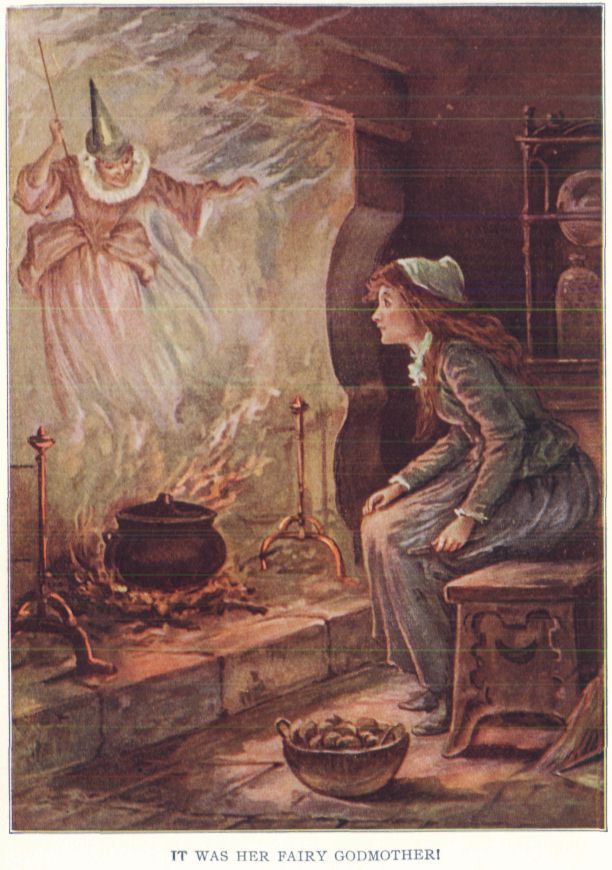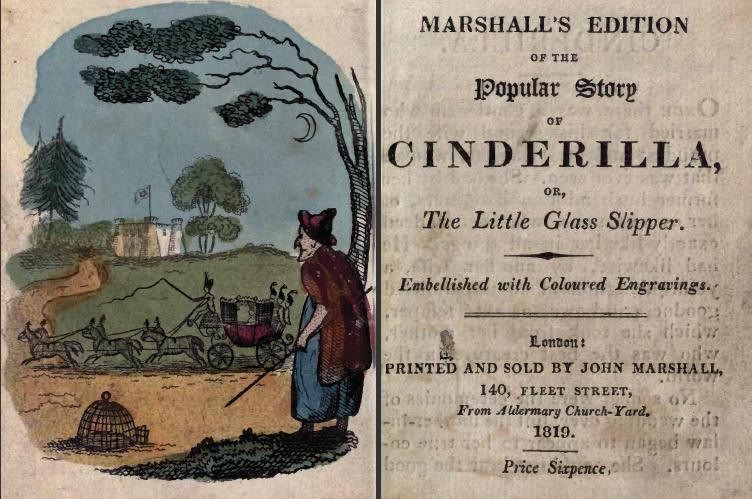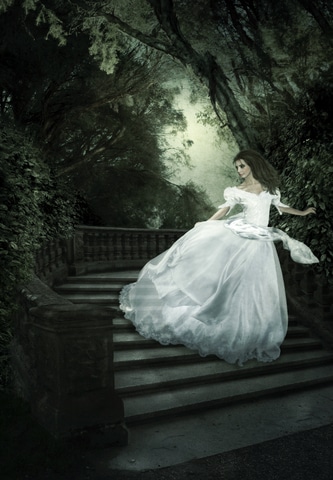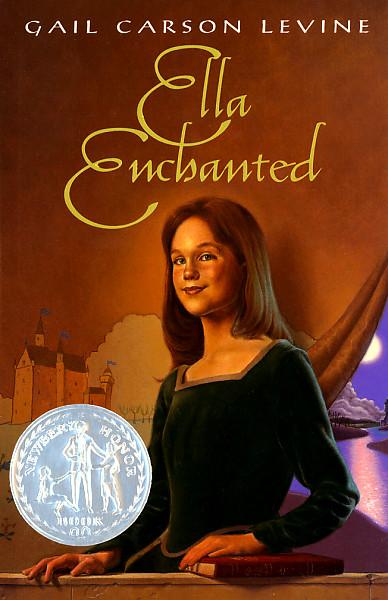THE FAIRY TALE: Cinderella
THE SOURCES: “Beauty and Pock Face,” Perrault, and Grimm variants.
THE MEDIUM: Literature
THE BOOK: Ella Enchanted
HISTORY & ANALYSIS

http://www.gutenberg.org/etext/19993
The Cinderella fairy tale has been around for as long as anyone can remember. It likely originated in ancient China or Egypt, “Rhodopis,” about a Greek girl who marries an Egyptian King recorded as early as the 1st century BC. Countless variants have been told over the centuries, Cinderella classified as “the persecuted heroine” in the Aarne -Thompson system. Most follow a basic structure that focuses on a young woman, Cinderella (though not always what she is called), who must prove that she is the rightful successor in a house in which she has been deprived of her rights, tormented by the jealousy and discrimination of her siblings and stepmother. The tale always starts out with a beautiful young girl whose mother has just died and been replaced by a stepmother and stepsisters. These new members of the household lower the girl’s status and force her to serve them.
After some time in the tale passes, the mother and stepsisters exclude the girl from a mother/daughter outing. The girl asks if she can join them. The mother agrees but then sets an impossible task as a condition for her to go. However, even if she completes the task she is still not permitted to go. After the family leaves on the outing, the girl gets help from some type of figure who symbolizes her dead mother. This mother figure assists her in going to the event that the rest of the family attends. The girl finds her true love at the event and is united with him after losing one of the slippers she is wearing. With this basic outline of the tale, other people and cultures still render vastly different versions of the story. Three different versions of the tale that demonstrate the wide scale of possibilities for this tale are one Chinese version of Cinderella, Perrault’s telling of Cinderella and the Grimm brothers’ version of Cinderella.
THE CHINESE CINDERELLA
One of the earliest known versions of Cinderella dates back to ancient China sometime around 900 A.D. It is called “Beauty and Pock Face.” In this version, Beauty’s mother died and is replaced by a stepmother and only one stepdaughter (Pock Face because she has pock marks all over her face). Beauty’s mother turns into a yellow cow when she dies. The yellow cow in this version of Cinderella is much like the tree that represents Cinderella’s dead mother in the Grimm’s telling. Beauty is very attentive to the cow, it representing the Chinese’s ancestor worshiping culture. Honoring one’s ancestors was very key in the Chinese culture. This story gives an example of it being very beneficial to not forget the people who have passed on. This obvious relationship between the mother figure(here the cow) and the girl’s dead mother is most prominent in this variant.
The figure, whatever it may be, that assists Cinderella is always thought of as being a representation of the good mother. According an experts in the field, Bruno Bettelheim claims that the tree “symbolizes…the memory of the idealized mother of infancy” (Uses of Enchantment, 257). It is this memory that helps the girl to get through the bad times with the wicked stepmother. Often, the story is also about independence. Sometimes, children see their parent as having been transformed into this evil stepmother. The child remembers fondly the way their mother used to be.
In “Beauty and Pock Face,” Beauty’s mundane tasks are to straighten out all of the hemp on her stepmother’s room and separate sesame seeds from beans. Both of these tasks are unique to the ancient Chinese culture. The Chinese commonly ate sesame seeds and beans at that time. They also regularly cultivated and used hemp in ancient China. The cow assists her with these chores, and supplies her with suitable clothing to go out.
As for the ball, the stepmother and daughter instead go out to the theater frequently, while Beauty desperately wishes to go. In ancient China, the monarchs did not really hold grand balls for all of the wealthy and noble people to attend. It makes sense that in that time and culture the theater would have been their equivalent to going to the ball.
The tiny slippers are a special focus in this version because of the ancient Chinese practice of binding women’s feet in order to keep them tiny. A tiny foot marked extraordinary virtue, distinction, and beauty, hence the name Beauty given to the girl. The Chinese also thought tiny feet symbolized sexual attractiveness, which makes it suitable that only her true love can return her tiny shoe. This makes the slipper extremely important since the goal of women at that time was to make a good marriage. The shoe is also described as being embroidered and made of precious material. This type of description is one of the facets that points to its Eastern origin.
At the point in the tale when Beauty rides to the theater and her slipper falls off of her foot, her tiny slipper catches the eye of passers by. Unlike the most familiar variant, here a prince does not search for the girl with the slipper, but rather the girl does the searching. When her slipper drops, different men pass by and notice the dainty slipper. They offer to pick it up if she agrees to marry them. Beauty refuses until a scholar comes by and she agrees to marry him. Beauty turns the suitors away by announcing their faults very similarly to how a young woman might feel about choosing the right husband. Beauty’s acceptance of the shoe is her acceptance of her husband as the perfect fit keeping with the idea of the feet as a sexual object.
Unlike other versions this telling does not end with the scholar marrying Beauty. Instead, they get married and decide to visit her family. During the visit, Beauty is killed by her family and the stepmother tricks the scholar into believing that the stepsister is his wife. Beauty, however, like her real mother, is reincarnated as multiple objects as she warns her husband of their deceit. After each incarnation, the stepsister recognizes her foils to snatch Beauty’s husband. In one instance she turns into bamboo. The theme of reincarnation is prominent in this version. It is likely rooted in Buddhism, a widely followed religion in ancient China. The bamboo bed ends up in an old woman’s house next door. The old woman helps Beauty by assembling different household items to make up her body, magically allowing Beauty to assume her former shape.
When Beauty returns to claim her husband, the sister insists that she is a fake. The two women perform various tasks in order to prove which one is the real wife, like in the Norse tale East of the Sun and West of the Moon. These tasks show the mark of the culture it was written for. The tasks center on the cultural importance of being delicate, represented by small or dainty feet. The first task is to walk on eggs and not break them. The second task is to walk up a ladder of knives and not get cut. Both of these tasks require walking and treading lightly one’s feet. This obsession with feet throughout the tale is very particular to this Chinese variant. In other versions, the slipper, while important, has lost its original meaning. In this one, Beauty gets revenge on the people that were cruel to her through their deaths (the stepsisters do often get terrible ends). The stepsister dies while attempting the tasks. After the sister’s death, upon seeing her daughter’s bones in a box, the stepmother also dies. Death and revenge are two themes that are not included in the most popular version of Cinderella.
PERRAULT’S CINDERELLA

Perrault’s widely popular telling of Cinderella, “The Little Glass Slipper,” is written much later in 1697. This version, written in France during the time when fairy tales were being rewritten to influence and appease polite society, focuses a great deal on the virtue of Cinderella in contrast to the vanity of her step mother and siblings. For example, the stepmother and sisters had full-length mirrors in which they admired themselves. In Perrault’s time, people viewed full-length mirrors as an extravagance.
Vanity is also a cardinal sin in most fairy tales. Cinderella’s cruel stepsisters and stepmother symbolize the evils of vanity by constantly admiring themselves in the mirror. Cinderella, in contrast, is forced to sleep in the ashes by the fire symbolizing her mourning her mother’s death. Despite her beauty being hidden by the ashes, she is still more beautiful than her stepsisters.
Cinderella is also described as extremely goodhearted. Like the heroine in the Beaumont version of Beauty and the Beast, Cinderella is kind and only wishes the best for her sisters even when they treat her horribly. For example, when the stepsisters ask her to make them look nice for the ball, she makes them up to be stunning rather than ugly. Her goodness is revealed again at the very end of the tale when she arranges marriages with noblemen for her stepsisters rather than punishing them. However, only Perrault’s telling depicts Cinderella as so forgiving. Cinderella allows the stepmother and stepsisters get their comeuppance at the end of many other versions. The rather preachy quality of the tale, and Perrault’s goal of teaching morality to the story’s young readers explains Cinderella’s behavior here, Cinderella’s virtue and moral values being rewarded in the end.
As for this version’s fairy godmother, she just appears out of nowhere. She is not as connected with her deceased mother as the cow in the Chinese variant or like the tree in the Grimm’s tale. In the other examples, Cinderella also cares for the creature that is her helper and representative of her mother. By disconnecting the fairy godmother from Cinderella’s deceased mother, Cinderella no longer receives her help by caring for the reincarnation of her mother. This factor is replaced by rewarding virtue for its own sake.
Perrault also invented the glass slippers and the coach and attendants appearing. The attendants are most likely a reference to the way a high born person would have traveled to a ball during Perrault’s time period. The glass slipper is thought to be a jest by Perrault since a glass slipper should have broken when it fell. All of the changes that Perrault makes, serve to create a more shallow and acceptable telling of the story to the conscious and unconscious mind.
Perrault version, unlike the Grimm’s, described in the next paragraph, the sisters’ mutilation of their feet is also not included, diminishing the underlying message of the story. According to Bettelheim, Perrault transforms the story in order to make it more acceptable to the society at that time and to address their political and social issues. It was also meant to be a story that is used for the purpose of teaching children a moral lesson. It does not go into the process of dealing with children’s subconscious problems as much as the other versions. Only the most obvious problems such as sibling rivalry is brought to the surface.
THE BROTHERS GRIMM CINDERELLA

Author Anne Anderson (1874-1930)
The Grimm’s version of Cinderella, written first in 1812, also put in many little moral lessons for children. For example, when the mother dies, she tells Cinderella that if she is good and pious that the Lord will assist her, and that she will look down on her from heaven and take care of her. Furthermore, when the stepmother and stepsisters arrive, the writers point out how beautiful and fair Cinderella is compared to how wicked and nasty the hearts of the stepsisters are. Because of their wicked hearts they will doubtless have difficult times ahead of them. The Grimm brothers were forced to revise their stories to make them more suitable and beneficial to the middle class children of the time, hence the preachiness. However, unlike Perrault they kept all of the important symbolism of earlier versions of the story.
Here, the father is more prominent, standing aside while Cinderella is treated poorly. Bettelheim is just one critic who believes the story deals with the oedipal desire of the daughter (245). The stepmother’s cruelty stems from her jealousy of Cinderella and her previous good relationship with her father. This new separation from her father is the beginning of Cinderella leaving behind this oedipal desire and finding love with her marital partner, the prince. When her father goes to the fair, Cinderella asks for him to break off the first twig that brushes against him. When Cinderella gets this twig she plants it at her mother’s grave, and waters it with her tears. Through Cinderella’s loving cultivation of the plant it grows into a beautiful tree. Cinderella is able to arrange things so life in the world will become good. Through her own work and emotion she really frees herself from servitude. The birds that come to this tree are the ones that assist Cinderella in the tasks she is given. The tree provides her with the dress and the silk slippers. Children who read the story would learn that they are rewarded for care and cultivation. Nature gives her material objects she needs to complete her story.
On one hand Cinderella is very connected with nature via her deceased mother, and on the other hand she is still living in a world that is very centered around material objects. Cinderella has almost ascended above such mortal objects through her caring of the tree and in turn her internal growth throughout the story. To completely free herself from servitude in the type of material culture she lives in, however, she must still turn back to such temporal items.
When Cinderella goes to the ball she teases or flirts with the prince, even if it might be on an instinctive level. When Cinderella runs away from the prince she is behaving coyly, and her this act only attracts the prince more. This is an example of a maiden engaged in skillfully fetching herself a husband, an important aspect of the life for women of the time. Fetching a husband was a top priority.
One other very important aspect that is included in this version of Cinderella is the sisters’ mutilation of their feet. Part of Cinderella’s oedipal anxiety is her desire for a penis or male counterpart, and the fear that she will have to go through self castration, or in other words she will never find her male counterpart. The sisters’ mutilation of their feet symbolizes this castration. Cinderella does not have to castrate herself in the end. Bettelheim claims that when Cinderella puts her foot in the slipper she is accepting herself and her femininity and the prince as her counterpart or penis. Likewise, the prince chooses Cinderella based on her shoe signifying his cherishing of her femininity. In essence the story deals with her fear of never finding her counterpart, or never getting married rather than her literal desire for a penis (271). To the Grimm’s audience, marriage was vitally important.
What is so great about the fairytale is that a lot of these messages can also easily pertain to people today as well. These three versions of the Cinderella fairy tale serve to help sort through the anxieties of the people in its time period. Some of them achieve this better than others, and some versions fall short due to constraints put on the writer by the society in which they lived. The little details and changes in the different stories give good pictures of the people they were written for. The messages in the stories are still instructive because people today can read them, and use the stories lessons to deal with similar problems in today’s world.
A MODERN CINDERELLA
And now we come to our modern adaptation of this tale, Ella Enchanted by Gail Carson Levine. This is one of my favorite books of all time, as you might have guessed if you’ve read some of my blog posts and top lists. This book was very important to me as a young adult. It comforted me many times when I needed some kind of solace from the outside world. In essence, this book did what the original fairy tale is intended to do: it helped me work through my problems subconsciously as I read it. I can say definitively that Ella Enchanted taught me how to deal with certain problems I confronted in life. It helped me grow up and mature a little bit, which is exactly what the tale is supposed to facilitate.
THE GOOD
Gail Carson Levine did a wonderful job of modernizing the Cinderella tale and making it more accessible for today’s audience. While set in a different land and different world altogether, the characters and their problems feel close to home and are easy to relate to. The main character, Ella, is a feisty young woman dealing with the grief of losing her mother while at the same time having to confront the fact that she has a horrible scheming louse for a father. When her mother dies she is essentially orphaned, since her father never really had much of a presence in her life to begin with. Ella also has to cope with growing up and the introduction of an attractive man in her life. To round out the whole experience, Levine gives her stepsisters that remind one of the mean girls at school, something I’m sure many of you have had to deal with at one time or another. So, we have problems and obstacle that our heroine is facing that we can all relate to and understand.
Levine also cleverly transforms her heroine into her own savior and, in fact, gives her characteristics of a classic fairy tale hero. She does all this while still retaining her characters innate femininity. In this version of the fairy tale, Levine sends Ella on a quest, a trope usually reserved for male heroes in classical tales. This gives the heroine a greater independence and power than the original character of Cinderella. Ella even has a moment where she does in fact save the hero, our prince, from ogres. Levine has truly changed thing around in her version of the fairy tale. Levine turns her into someone girls can look up to and want to emulate.
What I think is particularly clever on Levine’s part is that she keeps the imagery of the glass slipper. This allows for the same kind of interpretation as with the original tale, except Levine changes things around just a tad. Instead of the triumph being in the prince finding Ella and fitting her foot in the glass slipper, it is Ella’s ability to accept that slipper, break her spell, and embrace her love for the hero. This places Ella in the part of the hero rather than giving all the credit to the prince, as the original fairy tale does. Levine has turned the tables on the tale, and made our previously meek female into an empowered heroine. Ella is able to save herself not only from the curse and her family, but also from dangerous threats, such as the ogres, as we saw earlier in the story. She creates a character young women can look up to as a role model of empowered femininity, suitable to this modern age.
THE BAD
Ok, I’ll admit it. I really have nothing bad to say about this book. I think it’s brilliant and it is one of my favorites. So, instead I would like to point out what a perfectly awful villain Gail Carson Levine created. Dame Olga reminds me of a fat oily snake. Yes, I know snakes aren’t generally fat (at least none that I have seen), but this one would be. When I read about her, I can practically smell the cloying perfume covering some fetid body odor. She’s honestly one of my most hated villains. Let’s just say that I love to hate her.
THE UGLY
Now, let’s move on to Hattie. I absolutely loved that she wears a wig. Someone so mean and disgustingly cruel deserves to have horrible hair at the very least. Levine did a perfect job of making a daughter character that is literally like a smaller, younger version of her mother. I get the same cloyingly sweet taste in my mouth with Hattie that I get with Dame Olga. I absolutely love to hate them both. I almost wish Levine had decided to go with the Grimm Brothers’ ending and have her toes cut off. But, ah well, we don’t always get what we want.
CONCLUSION
So, we have one great fairy tale and an even better adaptation on our hands. Today we’ve seen four different versions of Cinderella. All of them are quite unique and different, catering to their time period and audience. All are equally enlightening when one takes a closer look at them. I hope you’ve gained a better understanding of the tale, and that I’ve sparked your interest in looking under the surface of some other tales or even Cinderella to a greater degree. What lies beneath can often be quite surprising. I also hope an highly recommend that you go straight away and read Ella Enchanted if you haven’t already, as it is most definitely worth it. Till next time!
Reference
Bettelheim, Bruno. The Uses of Enchantment: The Meaning and Importance of Fairy Tales.
Do you have any tales you would like me to take a closer look at? What is your favorite version of Cinderella? Sound off below…
RELATED
If you liked this analysis of a fairy tale make sure you check out my other blog posts, Behind the Folk Tale. Start with Beauty and the Beast: A Bit of History.
If you enjoy fairy tales, and would like to see some on the big screen try out Autumn’s Top 20 Fairy Tale Films.
Take a peek at the Top 20 Folk Tale Adaptations in Literature to Curl Up With on a Rainy Day.
ARE YOU A ROMANCE FAN? FOLLOW THE SILVER PETTICOAT REVIEW:
 Our romance-themed entertainment site is on a mission to help you find the best period dramas, romance movies, TV shows, and books. Other topics include Jane Austen, Classic Hollywood, TV Couples, Fairy Tales, Romantic Living, Romanticism, and more. We’re damsels not in distress fighting for the all-new optimistic Romantic Revolution. Join us and subscribe. For more information, see our About, Old-Fashioned Romance 101, Modern Romanticism 101, and Romantic Living 101.
Our romance-themed entertainment site is on a mission to help you find the best period dramas, romance movies, TV shows, and books. Other topics include Jane Austen, Classic Hollywood, TV Couples, Fairy Tales, Romantic Living, Romanticism, and more. We’re damsels not in distress fighting for the all-new optimistic Romantic Revolution. Join us and subscribe. For more information, see our About, Old-Fashioned Romance 101, Modern Romanticism 101, and Romantic Living 101.


